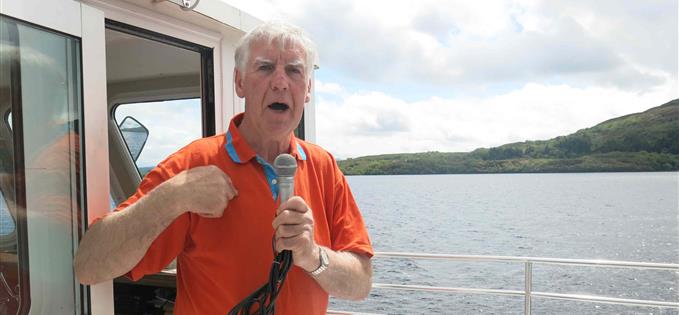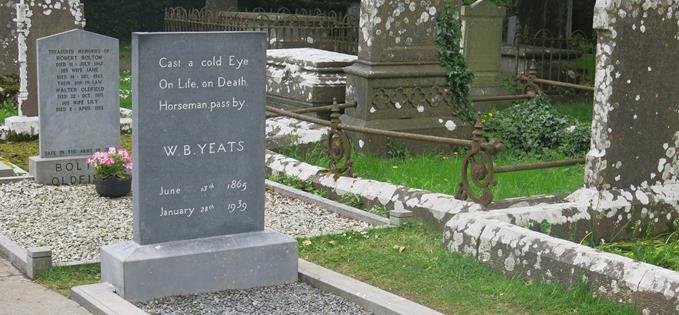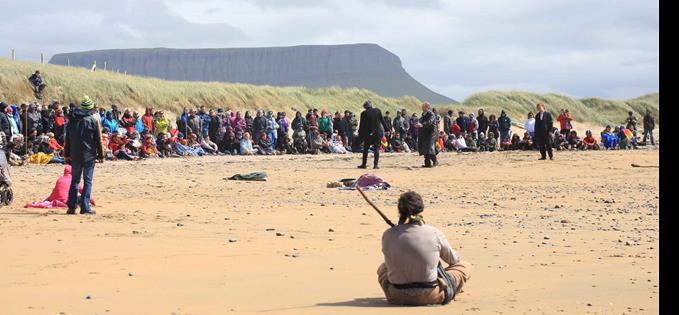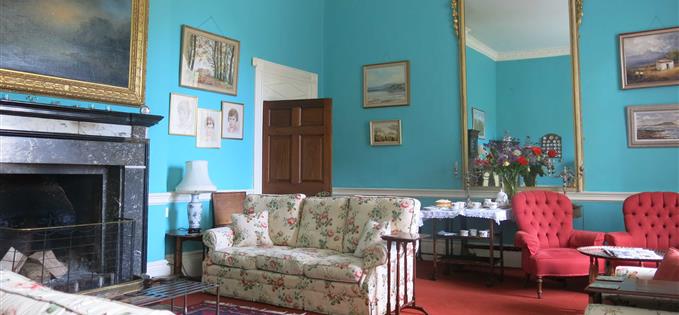HARGADONS pub in Sligo Town has changed a bit since last I was in. It’s not the look of the place necessarily – new owners the Monahans have tidied it up but its delightful maze of dark-panelled, cluttered rooms remains intact. The restaurant part now seems on equal terms with the swigging Guinness imperative, while there is a wine shop attached as part of the Johnson Court Shopping Mall, which definitely wasn’t in evidence a decade ago. Oh and there’s a man reciting his favourite WB Yeats poems outside the snug because it’s 1pm.
We missed the Harp Festival, which takes place every full moon throughout 2015
Willie Yeats (1865-1939) is big news this year, the 150th anniversary of his birth. He came into this world a year after Hargadons. Both are Sligo institutions with one difference. The great poet spent childhood summers in the area, wellspring for much of his early and middle period verse, but rarely returned later in his life. That isn’t going to halt the Yeats Country tourism industry and why should it? Everybody should be encouraged to visit this beautiful corner of the West of Ireland.
We arrived too late for the major celebrations. On Yeats Day (his birthday, June 13) there were parades for those just out to have a spot of fun and, naturally, speeches plus a posse of national Poet Laureates, including our own Carol Ann Duffy, descending on the town to celebrate in verse. The man’s face is on stamps and shuttle buses, even gent’s outfitter’s windows and everybody seems to want a selfie at the poet’s statue on Stephen Street. What is a shame is the disappearance of the town’s two best bookshops, including Keohane’s, a great Yeats trove, as I recall.
 Spouting Yeats in the pub; below, and on the boat
Spouting Yeats in the pub; below, and on the boatStill at Hargadons every day throughout the year at 1pm (6pm Sundays) you can book in to declaim a Yeats poem. Our man – who sounded like he came from Yorkshire – knew by heart his favourite, Aedh Wishes For The Cloths of Heaven – the one that contains the famous line ‘Tread softly because you tread on my dreams’.

The next day we trod softly on to a boat called the Rose of Innisfree to circumnavigate the Lake Isle, inspiration for Yeats’ most famous poem. Skipper George McGoldrick has been running these twice-daily 90-minute cruises from Parkes Castle on Lough Gill since 1999. At just 15 euros for an adult, they are fun and unintimidating. George plays Yeats’ own 1936 recording of the Lake Isle of Innisfree – so mannered to our modern ears – and recites a few other works himself, while his wife Christina serves tea, scones and Guinness.
The actual Isle, small and overgrown, is less than exciting. Below Dooney Rock, also made famous by Yeats in ‘The Fiddler of...’, lies the much prettier Cottage Island that might equally have been Yeats’ inspiration. It is known locally as Beezie’s Island, after an old lady called Beezie who lived alone there until she died in 1948, rowing across to Sligo every Thursday to collect her pension and shopping.
 Innisfree paddle boarding
Innisfree paddle boardingA stand-up paddle board is one contemporary way to land on Innisfree. Coopershill where we were staying offers a Yeats 150 romantic package that includes that method of transport from shore to Isle for an hour’s picnic. A couple we met at breakfast who’d booked had fallen in!
 Yeats grave at Drumcliff; below, the view of Ben Bulben
Yeats grave at Drumcliff; below, the view of Ben BulbenIt is a 20 minute drive from Parkes Castle, to the essential place of Yeats homage – Drumcliff graveyard, where he is buried under a tombstone with, of course, his own epitaph: “Cast a cold Eye/ On life, on Death/Horseman pass by.” He died in the South of France in 1939 with the unfortunate matter of the transfer of his remains held up for nearly a decade.

There is some uncertainty whether the right bones made the journey, but they have a beautiful resting place with the limestone bulk of Ben Bulben mountain in the distance (he wrote about that, too). His great grandfather had been rector here at a site dating back to a monastery founded by St Columcille (Columba) in 574. It’s an essential stop-off on the heritage coach tour route, but the coffee shop is good and it remains a copacetic place with St Columcille’s round tower and high cross extant.
So too is Streedagh beach to the north – almost in Donegal but still overshadowed by Ben Bulben. Here the Blue Raincoat Theatre Company were performing On Baile’s Strand (below), the first of three Yeats plays for the summer on this glorious stage set where the Spanish Armada was wrecked in 1588. It is one of many Celtic Twiliight honouring events in Yeats Year – we missed the Harp Festival, which takes place every full moon throughout 2015.

Streedagh is one of many fine beaches in the area, perfect for long walks. Surf-centre Strandhill is very much the hectic Sligo Town beach, so I'd head north head for the vast and unspoilt Rosses Point strand (below), which also has some great pubs nearby.

In the same area lies Lissadell House, which holds iconic status in Yeats myth-making. Here, at this austere Ascendancy country house Yeats used to call on the Gore-Booth girls, Eva and Constance (later to become Countess Markievicz, an Easter 1916 heroine – or traitor, depending on your view – and the first woman elected to the British House of Commons). He wrote memorably of them “both beautiful, one a gazelle”.
Under a new family regime, Lissadell (main picture) is resurgent, with a Yeats Gallery devote to WB and his brother Jack, an acclaimed painter who also captured from afar the landscape of Sligo. The gallery was opened five years ago by Leonard Cohen, who happened to be playing a comeback concert in the area. He apparently did the Rose of Innisfree tour, surprising Skipper George with a 50 euro tip – he had no idea he was hosting another eminent bard!
 Coopershill; below, its wonderful public rooms
Coopershill; below, its wonderful public roomsLissadell, a neo-classical Greek Revival pile, dates from around 1830. Coopershill House, ancestral home of the O’Haras at Riverstown 20 minutes to the south of Sligo, was built 60 years earlier and is altogether more harmonious architecturally amid its 500 deer-haunted acres.


We’d stayed there before when it was run by Simon O’Hara’s parents. They are still involved, but today it’s very much the project of much-travelled Simon and his fiancée, Christina McCauley, who cooks dinner for lucky folk who stay at this country house that just happens to have a few characterful rooms to stay in. Typical of the gloriously relaxed approach of properties subscribing to join Ireland’s Blue Books, an umbrella organisation embracing the country’s finest destinations.
To reach Coopershill you leave the high-octane N4 and eventually find yourself climbing on a rough track through a green web of woodland to a kind of Lost Domain, croquet on the lawns, stag’s heads aplenty on the staircase, the ghosts of a turbulent past whispering in every cranny. Nowhere does this as well as Ireland. The upkeep of such places is prohibitive; it is almost a duty to support them. Yeats would have understood.
Fact file
Neil Sowerby flew from Manchester to Dublin with Aer Lingus.
He hired a car from Hertz and Ireland’s greatly improved motorway network got him out to the west coast in just over two hours.
His base for Yeats Country was Coopershill House, Riverstown, Co. Sligo. +353 71 916 5108. Doubles from 200 euros a night including breakfast. It is part of Ireland’s Blue Books, a collection of unique country houses, historic hotels, manor houses, castles and restaurants across the country. Look out for their special offers.
Details of events, both in Ireland and internationally, to celebrate Yeats’ 150th birthday can be found on yeats2015.com.
There is a further Yeats Country to the south, between the towns of Gort and Loughrea in Galway, centred on the Lady Gregory Yeats Trail. Based at Coole Park – now a nature park, the house long gone – she was a patron of Yeats and the Irish Literary Revival. The essential place to visit in the area iis Thoorballylee, a 16th century fortified Norman castle the poet bought for £35 in 1917 and lived in with his family from 1921 until 1929.
The Wild Atlantic Way is Ireland’s inspired branding of that entire coastal touring route from the wild limits of Donegal down to gourmet hang-out Kinsale in Co. Cork. Tourism Ireland is making great play of the Way and Yeats this year. An excellent guide to the food and drink delights along the WAW is John and Sally McKenna's Where To Eat And Stay on the Wild Atlantic Way (Estragon pb, www.guides.ie)















